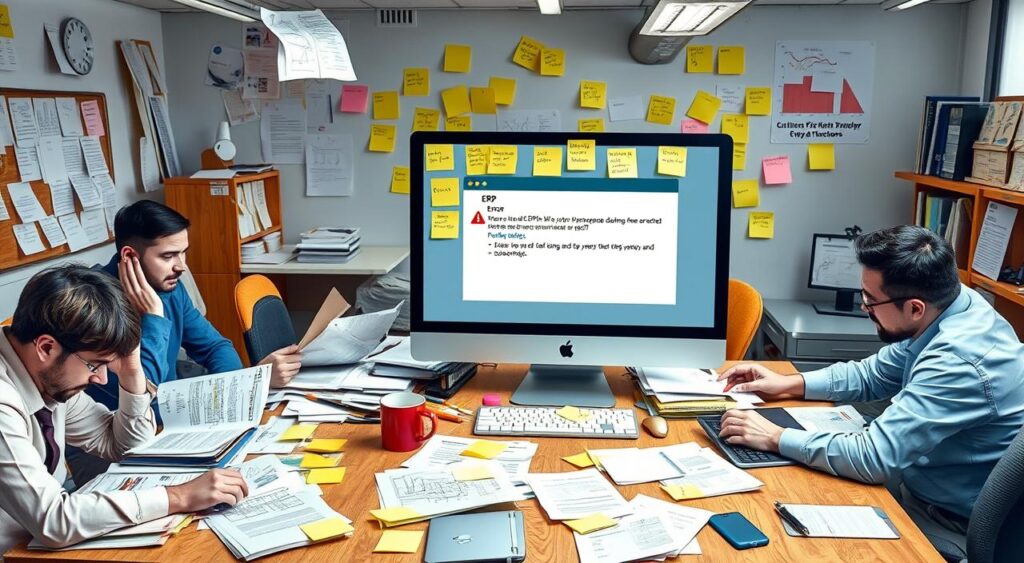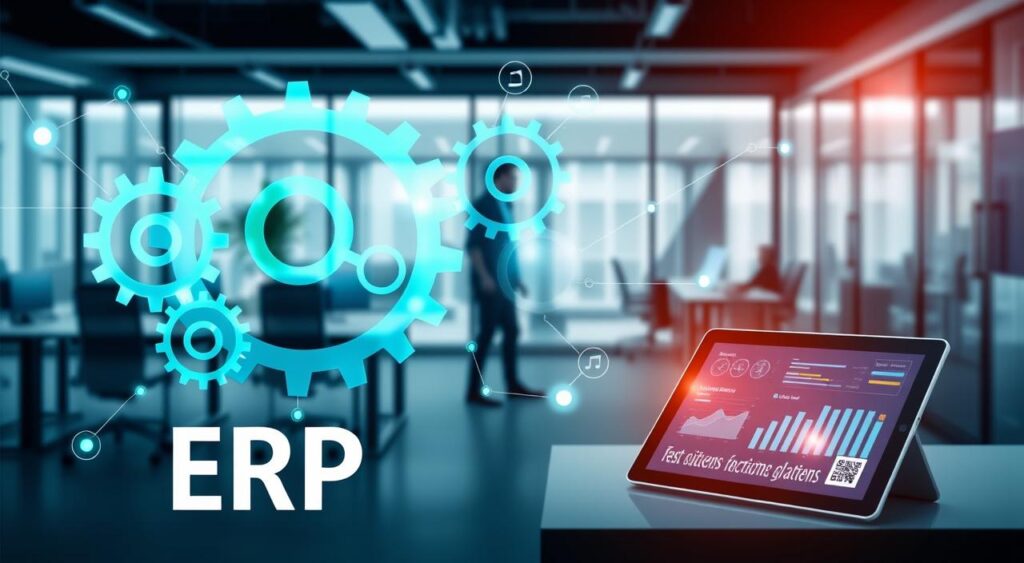https://noticviralweb.blogspot.com/2024/04/consejos-erp-empresa.html
If you own a business, you’re probably searching for ways to make things run smoother. This is where erp software comes in. It can help your business grow by following erp best practices. Let’s look at how these practices can help your company.
Using the right erp system can make things easier and cheaper. It lets you handle finances, supply chain, and customer relations all in one spot. This way, you can stay competitive and reach your goals.
Following erp best practices ensures a smooth setup and gets the most out of your system. Whether your business is small or big, erp can help you excel. Next, we’ll explore more about erp solutions and how they can change your business.
Key Takeaways
- erp software for businesses can help streamline processes and improve efficiency
- erp solutions for companies can reduce costs and increase productivity
- erp best practices are essential for a successful implementation
- erp systems can help you make informed decisions and stay ahead of the competition
- erp software for businesses can be tailored to meet the specific needs of your organization
Understanding Modern ERP Systems
Exploring enterprise resource planning (ERP) reveals its many benefits for businesses. Modern ERP systems help streamline operations, making them more efficient and cost-effective. They also improve visibility, decision-making, and teamwork.
Modern ERP systems stand out due to several key features. These include:
- Cloud-based deployment options
- Mobile accessibility
- Real-time data analytics
- Artificial intelligence (AI) and machine learning (ML) capabilities
Understanding modern ERP’s capabilities helps you make smart choices for your business. Optimizing business processes with ERP can greatly benefit your organization. The right ERP system can:
| ERP Benefit | Description |
|---|---|
| Improved Efficiency | Streamlined operations and reduced manual errors |
| Enhanced Visibility | Real-time data analytics and better decision-making |
| Increased Collaboration | Better communication and coordination across departments |
When thinking about ERP, remember its many advantages. By optimizing business processes with ERP, you can elevate your business and stay competitive.
Why Your Business Needs an ERP System Today
When thinking about changing your business, knowing about erp system deployment strategy is key. An ERP system can make your business run smoother, save money, and help you make better choices. To succeed, you need a good plan that fits your business goals.
An ERP system makes things more efficient. It automates tasks and gives you real-time updates. This means you can use your resources better and make smart decisions with the right data. To get the best out of your ERP, follow erp implementation success tips. This includes setting clear goals, getting everyone on board, and offering training and support.
For a successful ERP system, consider these points:
- Defining clear goals and objectives
- Engaging stakeholders and ensuring buy-in
- Providing ongoing training and support
- Monitoring and evaluating system performance
By following these tips and planning well, your business can thrive. Keep your goals in mind and always look for ways to improve your ERP system. This ensures it stays useful for your business.
Preparing Your Organization for ERP Implementation
Thinking about getting an ERP system? It’s key to get your team ready for the changes it brings. Start with a readiness assessment to spot areas for improvement. Also, check out tips for erp implementation to make the transition smooth. By doing this, you’ll avoid hiccups and enjoy the system’s full benefits.
To get ready for ERP, building a strong team is crucial. This team should have members from different departments. They’ll oversee the setup and keep everyone informed. Also, setting realistic timelines is important to avoid delays and extra costs.
- Define clear goals and objectives
- Establish a detailed project plan
- Provide training and support for end-users
By following these steps and erp best practices, you’ll set your organization up for success. This way, you’ll get the most out of your ERP system.
Selecting the Right ERP Solution for Your Business Size

Choosing the right erp software for businesses is crucial. It depends on your company’s size. Each business has its own needs. The right erp solutions for companies can greatly improve operations.
Before picking an ERP solution, think about a few things:
- Scalability: Can the ERP solution grow with your business?
- Customization: Can the ERP solution be tailored to meet your specific needs?
- Integration: Can the ERP solution integrate with your existing systems?
By looking at these points, you can find the best erp software for businesses. This ensures your company can handle its tasks well. Also, consider the cost and support from the ERP vendor for a smooth setup.
Critical Success Factors in ERP Implementation
Several factors are key to a successful ERP implementation. A well-planned ERP system deployment strategy is essential. Understanding these factors can help increase your chances of success.
Leadership buy-in and support are crucial. Effective communication ensures all stakeholders are on board. Employee training and engagement are also vital, as they will use the system daily. A good data migration strategy is necessary for a smooth transition.
Some tips for a successful ERP implementation include conducting thorough research and setting realistic expectations. Providing ongoing support to employees is also important. By following these tips, you can ensure a successful ERP implementation and improve your business operations.
Here are some key factors to consider when implementing an ERP system:
- Define clear goals and objectives
- Establish a strong project team
- Develop a comprehensive training plan
- Test the system thoroughly
By considering these factors and following ERP implementation success tips, you can ensure a successful ERP system deployment strategy. This will improve your business operations.
Common ERP Implementation Pitfalls to Avoid

When you’re using ERP to improve your business, knowing common mistakes is key. These mistakes can slow down your success. ERP helps make your operations smoother and more efficient.
Watch out for inadequate training for your team, poor data migration plans, and insufficient testing. Here are some tips to steer clear of these issues:
- Make sure to train your team well so they know how to use the new system.
- Plan carefully how to move your data to avoid problems and keep it accurate.
- Test the system fully to find and fix any issues before it goes live.
By being aware of these common mistakes and taking steps to avoid them, you can make the most of your ERP.
Optimizing your business with ERP needs careful planning and attention. Avoiding common pitfalls and following best practices will help you get the most out of your ERP system. This way, you can achieve great success for your business.
Maximizing ROI from Your ERP Investment
To get the most out of your erp software, focus on erp best practices. These practices help increase return on investment (ROI). They include cost control, tracking key performance metrics, and finding ways to optimize.
By using erp best practices, you can make your business run smoother. This means cutting costs and working more efficiently. You’ll see better productivity, smarter decisions, and happier customers.
Cost Control Strategies
- Implementing a robust budgeting and forecasting process
- Optimizing resource allocation and utilization
- Minimizing waste and reducing unnecessary expenses
Performance Metrics to Track
Keep an eye on revenue growth, customer acquisition costs, and employee productivity. These metrics help you spot where to improve. They guide you in making choices that boost your business.
By sticking to erp best practices and controlling costs, you can get the most from your erp investment. This leads to lasting success for your business.
Integration Strategies for Seamless Operations

When you choose erp solutions for your company, think about how to integrate them well. This means making sure all systems work together smoothly. This way, you can make your operations better, cut down on mistakes, and boost productivity.
To get seamless operations, you need to link your erp system with other business tools. This includes CRM and SCM systems. Use APIs or other tools to do this. This way, all data stays in sync, helping you make better choices.
Some big pluses of linking your erp with other systems are:
- Improved data accuracy and consistency
- Enhanced collaboration and communication
- Increased efficiency and productivity
- Better decision-making capabilities
Also, using erp to improve your business processes can help you find and fix inefficiencies. Look at your processes, find the slow spots, and make changes to speed things up.
For example, a company might use an erp system but not link it with other systems. This can lead to data problems. But, by linking the erp with other systems, the company can keep data accurate and up-to-date. This makes operations run smoothly.
By using smart integration strategies and optimizing your business with erp, your company can run better. This means more productivity, better decision-making, and a stronger position in the market.
| ERP Integration Strategy | Benefits |
|---|---|
| API Integration | Improved data accuracy and consistency |
| System Integration | Enhanced collaboration and communication |
| Process Optimization | Increased efficiency and productivity |
Security Best Practices for ERP Systems
When you set up your ERP system, think about keeping it safe. A secure ERP system is key to protecting your data and making your ERP work well. Data protection is a big part of ERP security.
Protecting your data should be your main goal with your ERP system. This means encrypting sensitive data and controlling who can see it. Only let people who should have access to your data get in.
Data Protection Measures
- Encrypt sensitive data
- Implement access controls
- Regularly update and patch your system
Also, think about who can get into your system and follow the rules. By doing these things, you keep your ERP system safe. This protects your data and keeps your organization secure.
Customization vs. Configuration: Making the Right Choice

Choosing between customization and configuration is a big decision for businesses using erp software. Each option has its own advantages and disadvantages. The best choice for your company depends on your specific needs and goals.
Customization lets you tailor your erp system to fit your unique business needs. This is great for companies with complex or specialized processes. Configuration, on the other hand, uses pre-built modules and templates. It’s often faster and cheaper but may not offer as much customization.
Customization offers increased flexibility and scalability. It also makes it easier to integrate with other systems. But, it can be time-consuming and expensive, needing a lot of technical expertise. Configuration is faster and more affordable, but it might not be as customizable as a tailored solution.
When deciding between customization and configuration, think about these factors:
- Business requirements: What are your specific needs and goals?
- Technical expertise: Do you have the in-house expertise to customize your system?
- Budget: What is your budget for implementation and maintenance?
The right choice between customization and configuration depends on your unique situation. By carefully considering your options and weighing the pros and cons, you can make an informed decision. This will help you get the most out of your erp software for businesses.
By choosing the right approach, you can ensure your erp system meets your needs. Whether you choose customization or configuration, the key is to find a solution that aligns with your organization’s objectives. This will provide a strong foundation for growth and success.
| Customization | Configuration |
|---|---|
| Increased flexibility and scalability | Faster and more affordable implementation |
| Ability to integrate with other systems | Pre-built modules and templates |
| Time-consuming and expensive | Limited customization options |
Cloud vs. On-Premise ERP: Choosing Your Deployment Model
You have two main choices for ERP deployment: cloud and on-premise. Each has its advantages and disadvantages. The best choice for your business depends on several factors. By following erp best practices, you can ensure a smooth deployment and optimal performance.
Choosing the right ERP system requires thinking about your business’s specific needs and goals. Cloud-based ERP systems offer flexibility and scalability. On-premise systems give you more control over data and security.
Comparing Cost Structures
Cost is a key factor when deciding on a deployment model. Cloud-based ERP systems often have a subscription-based model. On-premise systems require a big upfront investment. Here are some costs to consider:
- Initial investment
- Ongoing maintenance and support
- Scalability and upgrade costs
Scalability Considerations
Scalability is also crucial. Cloud-based ERP systems can grow or shrink as your business needs change. On-premise systems might need big upgrades or new hardware. Think about your business’s growth plans and choose a model that fits.
By carefully evaluating your options and following erp best practices, you can pick the right deployment model for your business. This will help optimize your business processes with ERP.
Change Management Strategies for ERP Success
Implementing a new ERP system affects your organization’s operations and employees. A good erp implementation success tips plan can reduce disruptions and make the transition smoother. It’s important to have a change management strategy that meets the needs of all stakeholders.
Effective communication is a key part of this strategy. You should tell your employees about the changes, train them on the new system, and offer support during the transition. This helps them see the benefits of the new ERP system and how it will make their work better. A solid erp system deployment strategy also helps spot risks and plan how to deal with them.
Here are some more tips for a successful ERP implementation:
- Do a thorough needs assessment to find out what your organization needs.
- Make a detailed project plan with realistic timelines and goals.
- Keep training and supporting employees ongoing.
- Watch how things are going and make changes if needed.
By following these tips and creating a detailed change management strategy, you can make sure your ERP implementation is a success. This way, you can get the most out of your new system.
Measuring and Monitoring ERP Performance
To get the most out of your ERP system, it’s key to measure and monitor its performance often. You should track important performance indicators (KPIs) that match your organization’s goals. This helps you spot areas for betterment and make smart decisions to improve your ERP system.
Common KPIs for ERP systems include order fulfillment rates, inventory turnover, and customer satisfaction scores. By keeping an eye on these, you can understand how well your ERP system is working. ERP benefits for organizations are huge, but only if the system is well set up and kept up.
Choosing the right erp solutions for companies is crucial. You need a solution that fits your specific needs and goals. This ensures your ERP system supports your business strategy and brings the benefits you want.
To make your ERP system a success, knowing your organization’s goals is vital. This helps you pick the right KPIs and make smart choices about your ERP system. By following these tips, you can maximize your ERP system’s benefits and achieve great results.
| KPI | Description |
|---|---|
| Order Fulfillment Rate | The percentage of orders fulfilled on time |
| Inventory Turnover | The number of times inventory is sold and replaced within a given period |
| Customer Satisfaction Score | A measure of customer satisfaction with the organization’s products or services |
Key Performance Indicators
- Order fulfillment rate
- Inventory turnover
- Customer satisfaction score
Reporting Best Practices
Regular reporting is key to keep an eye on your ERP system’s performance. This includes making reports on KPIs, inventory levels, and customer satisfaction scores.
Continuous Improvement Methods
To keep your ERP system successful over time, having a continuous improvement plan is vital. This means regularly checking and tweaking your ERP system to keep it in line with your goals and objectives.
Conclusion: Transforming Your Business with ERP Best Practices
Starting your ERP journey? The secret to success is best practices. Follow the tips in this article to transform your business and get the most out of your ERP system.
First, do a readiness assessment to get ready for changes. Build a team for the project and set achievable goals. Pick an ERP that fits your business size and needs.
During the setup, get leadership buy-in and involve your team. Create a solid plan for moving data. This way, you avoid common problems and make the most of your ERP.
The work doesn’t stop after setup. Keep monitoring and optimizing your ERP. Also, stay updated on security and compliance. With the right mindset and approach, your business will transform and thrive with ERP best practices.






